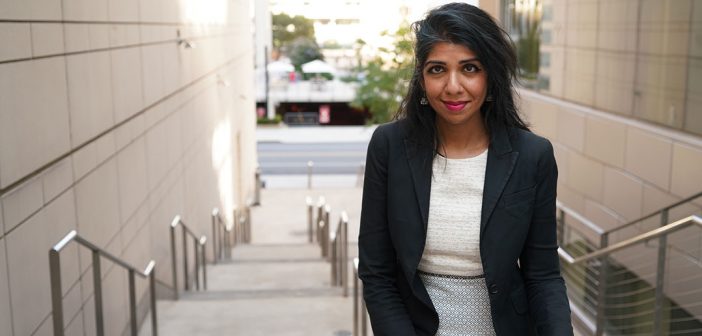In 2016, more countries experienced violent conflict than any time in the previous 30 years. From Yemen, Syria, and Venezuela to Myanmar, the Democratic Republic of Congo and Ukraine, violence has become a more common answer to resolving disputes, and one of the consequences has been that more people are displaced around the globe since World War II.
At the same time, the person elected as president of the United States, traditionally a role that has served as broker between warring parties, was elected on an “America First” stance.
Needless to say, the world needs more peace makers. The United Nations is one organization that tries to fill the void; it currently maintains 14 different peace keeping operations, and mediates negotiations for many other conflicts. Anjali Dayal, Ph.D., an assistant professor of political science, says that as flawed as the U.N. is, it’s still an absolutely necessary bulwark against spreading chaos.
Full transcript below
Anjali Dayal: We live in a world where the dominant idea about peacekeeping is that it fails, is that it doesn’t work that well, and that the UN is sort of a paper tiger. That turns out to not actually be the case.
Patrick Verel: In 2016, more countries experienced violent conflict at any time in the previous 30 years. From Yemen, Syria, and Venezuela to Myanmar, the democratic Republic of Congo, and Ukraine, violence has become a more common answer to resolving disputes. And one of the consequences has been that more people are displaced around the globe than any time since World War II. At the same time, the person elected as president of the United States, traditionally a role that has served as broker between warring parties, was elected on an America-first stance.
Needless to say, the world needs more peacemakers. The United Nations is one organization that tries to fill the void. It currently maintains 14 different peacekeeping operations and mediates negotiations for many other conflicts. Anjali Dayal, an assistant professor of political science at Fordham, says that as flawed as the UN is, it’s still an absolutely necessary bulwark against spreading chaos. I’m Patrick Verel and this is Fordham News.
In June, the United Nations estimated that nearly 71 million people were displaced around the world by the end of 2018. What’s going on?
AD: Conflict in three countries is the primary driver of the refugee crisis, according to the United Nations High Commission for Refugees. Conflict in South Sudan, Afghanistan, and Syria is responsible for nearly 60% of all refugee displacement in the world right now. This is really the most protracted refugee crisis that we’ve seen since the institutions that we have in place today were put in place at the end of World War II. It’s such a protracted crisis that it’s actually fundamentally remaking the domestic politics of host countries and potential host countries. You started out by talking about the America-first policy, US domestic politics is being reformulated in response to migration across the Southern border. Migration that’s driven by the legacies of conflict, migration that’s driven by climate change, migration that’s being driven by people desperate to flee crime and lack of economic opportunity.
Countries that have hosted the most refugees are usually neighboring countries. When we talk about like displacement from the Syrian crisis, for example, Jordan, Lebanon, and Turkey host most Syrian refugees. Lebanon has huge number of refugees in proportion to its domestic population. But it’s also a question further afield. In 2015 and 2016, people often talked about this as the European refugee crisis, even though very few in comparison refugees actually ever made it to Europe.
All of this is alongside the sort of important research that political scientists have done, and historians, and economists demonstrate that refugees are not huge drivers of crime. And so when we think about these kinds of crises, we’re talking about multiple compound humanitarian crises, systems that are strained to their breaking point in terms of being able to manage, process, and resettle refugees, countries that are not particularly willing to resettle refugees just as the crisis becomes most acute, and sometimes generational displacement, so people who are born into multiply displaced communities.
PV: Talk to me about the United Nations Security Council. Now, since Russia went along with a no fly zone resolution over Libya that the council passed in 2011, Vladimir Putin has since said it was a big mistake. Does this make it unlikely that the Security Council will ever back serious peacekeeping operations?
AD: In order to get a peacekeeping mission, you need a Security Council authorization. There are five permanent members of the Security Council, the UK, the US, Russia, China, and France. Any one of those permanent five members can unilaterally veto a mission. We only see peacekeeping missions in the world where no member of the P5 has a reason to veto.
What we end up seeing is a system in which cases where the permanent five members of the Security Council don’t have a really strong vested interest in the outcome of a conflict, they’re the ones that get peacekeeping mission. Now, we started about talking about the refugee crisis. Obviously, that’s a huge problem when we think about the number of refugees the Syrian conflict is generating. But this is a political set of calculations. It’s a disagreement about what Syria should look like between the permanent five members of the Security Council, so we’re not going to see mission there.
The Libya case is really interesting, because that is a case where Russia and China both abstained from the decision. They didn’t veto it. In retrospect, both, or Russia at least, has noted that they felt it was a mistake, that it was opening the door to greater action than was initially requested. That sort of exemplifies those dynamics. When they thought it was a more constrained mission that was not involved in regime change but for protection of a particular population, they were onboard with it, as they seem to be on board with other missions where they have fewer interests. When it became what they considered to be a regime-change endeavor, that’s something they’re uncomfortable with.
What we see in the world today is that we’ve got 14 missions where the P5 agreed pretty well. The problem is those fracture points, disagreements on Ukraine, on Syria, on the aftermath of what happened in Libya, those could actually fray the consensus that we have for other cases.
PV: Now, you wrote a book about why combatants and civil wars engage in the UN-led negotiations, even when they believe the UN is a failed flawed contributor to the peace process. I believe that was your term.
AD: Yes.
PV: What did you find?
AD: Yeah, so at the book manuscript is under review right now. The basic question that I had was the theory, the way we think about peacekeeping today, is that peacekeepers work to solve a security problem. They are usually, or traditionally they were sent out after the signing of a peace agreement. The important thing that they do in that situation is to help uphold the terms of the agreement. You don’t have to trust the other side to uphold their end of the agreement, you just have to trust the UN to be able to help you uphold the agreement. In a world where you’ve been willing to kill each other over something very recently, right, that’s a really valuable resource. Having someone help calm incredibly neutrally uphold your agreement, having them help you disarm, having them help you demobilize, having them provide you information about the intentions and the actions of your phone or opponents so that small accidents don’t spiral back into big, full-scale war again. Right? That’s a really critical set of things that the UN can help do, that UN peacekeepers can help do.
But in order for peacekeeping to actually work like that, people have to believe that the UN can credibly and neutrally uphold the terms of the agreement. We live in a world where the dominant idea about peacekeeping is that it fails, is that it doesn’t work that well, and that the UN is sort of a paper tiger. That turns out to not actually be the case. Right? It turns out that depending on how you count, UN peacekeeping missions are incredibly successful at upholding agreements. There’s a failure rate of about like one out of every four. You’re talking about three out of four cases of conflict. That’s not a bad success rate.
That isn’t the way we think about it though, because that fourth case is still important. The one that fails, people die, people lose their lives and it generates lots of news coverage. Then the question becomes what do they want the UN for? If they don’t think the UN is going to protect them, why are peacekeepers on the ground for them? The answer that I have is because there’s a full range of other things that UN peacekeepers do that are not actually related to security.
The presence of UN peacekeepers on the ground can bring you material benefits, it can bring your tactical benefits, and it can bring you symbolic benefits. If we start with material benefits, peacekeepers arrive and they infuse goods and services into the economy. You could have tactical benefit. If you really believe that the UN is not going to help you uphold your agreement, then you could use the time that they’re there to regroup or rearm, right? You could use the time that they’re there to help launch a counter attack. The last thing you could get is a set of really important symbolic and legitimacy benefits. Sitting down with the UN, inviting the UN to come help oversee your agreement, hosting UN peacekeeping mission, that’s a really good way to demonstrate to your former opponents, to the citizens in your country, to the larger world that you are genuinely invested in the peace.
PV: What’s the gold standard for peacekeeping mission in your mind?
AD: That’s a really good question. There are some big successes that people talk about, peacekeeping missions in Namibia, in Mozambique, in East Timor, interpositional peacekeeping missions, so peacekeeping missions between two countries as opposed to within a country. Lebanon, for example. That one’s a little more contentious today. But those are all missions that have in the long run prevented backsliding into war.
Much like the discussion about what counts as a failure, the question of what counts as success is loaded for a lot of people. For most peacekeeping scholars, it’s about five years without sliding back into war, which is not an insignificant accomplishment. But we should note that that doesn’t mean that peacekeepers leave behind a vibrant democracy where everyone is equal and flourishing. It just means there’s no war.
PV: Why are women key to diffusing conflict?
AD: At most, 3% of negotiators in peace processes are women. 97% of negotiators are men. Participants, it’s a similar divide. We see very few women in the room for peace agreements. Even though we don’t want to make a centralist arguments, that actually has real, and critical, and negative effects in the world. More inclusive peace agreements are more likely to last. The more people you have in a room reenvisioning the nature of the post-conflict state, the more likely you are to actually see an agreement that can actually produce a stable state afterwards.
There’s a trade off that negotiators sometimes make. They think, can we get these people to stop shooting each other? Right? Then can we arrive at a transformed society with a post-conflict vision of the peace to keep this from happening again? It really matters that half the society is shut out of a room. Especially because the concerns that women ring that are gendered are not irrelevant to the peace. There are things like local security. How easy is it to go get water at night in a dimly lit space or in a space with no light? How safe do you feel walking around? What is the likelihood that you are going to experience sexual abuse or exploitation in your lifetime? Right?
PV: I just want to come back to one particular number that really stood out when you said that. 97%?
AD: Yeah. These are UN statistics.
PV: That’s bonkers.
AD: It’s crazy. It’s absolutely crazy when people talk about like women in peace processes, I don’t think people really know that that’s the breakdown, right? Like, it is that extraordinarily male, the peacemaking space.
PV: So, it’s just assumed that the men would just know everything that’s going on with all the women in their live’s lives that they’re going to speak on behalf of them?
AD: Well, one of the things we see that’s really interesting is that there’s a journal article I have forthcoming in the Journal of Global Governance with my coauthor Agathe Christien who is a research fellow at the Institute For Women Peace and Security at Georgetown. We look at informal peace processes, like what people often broadly group as being like track two diplomatic initiatives, informal women’s movements for peace, informal women’s groups for peace, and it turns out women dominate the informal peacemaking space.
We looked at 63 different peace processes. Most of those processes we can identify a distinct set of women’s groups that are advocating for the peace. That we see that tells us something about the way these sort of axes of negotiation are separated, but it really also tells us that there is space for the formal peacemaking world to open up. The way it is now is almost like a throwback to like old diplomatic traditions. Women have been informally making peace for as long as there have been male diplomats in the world. Whether we think about like queen consorts or we think about like diplomats wives going out and hosting dinners, right?
PV: Isn’t there a story from the Greek times of women withholding sex to get the men to stop from fighting or something?
AD: Yeah, the Lysistrata?
PV: Yeah. That’s it. Yeah.
AD: Yeah, so like, women’s informal action to force a peace is like common. When we think about Lysistrata, we also think about like women in Liberia being incredibly active to try and force the formal parties to conflict into a negotiation statue. They surround the hotel, they say “You’re not coming out until you come out with a peace agreement.” Right? It’s this kind of informal action that demonstrates that even people who are shut out of formal processes are not passive in the face of their exclusion. They want inclusion.
PV: This is a topic that is not inherently a positive one. We’ve talked a lot about all of the death, and displacement, and conflict in general. What gives you hope?
AD: I think a lot about Rebecca Solnit’s work, in particular Hope in the Dark. She writes, “Hope is not a lottery ticket that you sit down on the sofa with and wait for something to happen. Hope is an axe, and you use it to break down what stands in your way.” For me, what gives me hope is seeing, even despite how difficult some of these issues are, how committed some people are to solving them. I spent a lot of time as a kid watching Sesame Street and Mr. Rogers. Often in crisis moments, people turn back to Mr. Rogers, look at the helpers, right? That sort of idea of what should-
PV: Oh, wow. Yeah.
AD: Yeah, exactly. What should you tell children when something is really difficult? You tell them to look for the people who are trying to help. I think that’s true for adults, also. Not just to see that people who would like to change things exist in the world, but that you can become one of them. Right? That it’s not an insurmountable barrier.
The other thing we might think about is, I think it’s a Talmudic set of expressions, right, that you aren’t obligated to alleviate all of the world’s suffering, right? But that doesn’t absolve you from taking up any of the task. One of the ways we’ve seen that is with the Youth Climate Movement. That’s the source of a lot of hope, I think, to a lot of people. It’s a troubling source of hope because it is children getting up and saying to us like, “We’re desperate. We need you to do something.” But it is instructive to see that mass movements like that can build, right?
Something like climate change, individual action can’t help us resolve that. That’s also the case for things like violent conflict or a refugee crisis. But enough individual decisions to participate in pressuring governments and holding them to account demonstrates that these are issues of importance to people. Right? If we can get in this space of a year, a Children’s Youth Climate Movement to come and shut down cities or to come and make sure people are aware that children everywhere invested in this issue, right? That isn’t a straight success, but it is a hopeful thing. It’s the kind of thing that just says, “Okay, this is an axe. We can use it. We can use it to break down apathy. We can use it to break down the kind of avarice and the kind of greed that can keep us from arriving at collective solutions to problems.”



